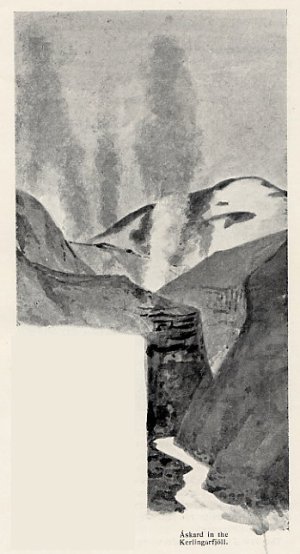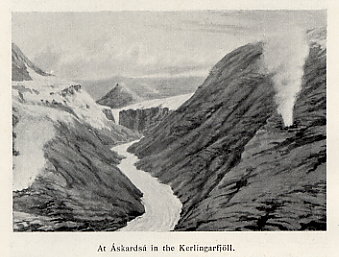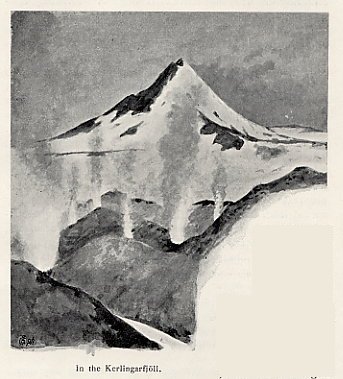|
An exceptionally interesting branch excursion may be made
from Gránanes to the Sulphur Springs at Kerlingarfjöll, which
I will describe from my experiences in 1897. Gránanes is a
low grassy promontory in the fork of the two tributary rivers
which form Svartu. We arrived there on the 8th August. It
was twilight on the plains by the time the tents were
pitched and Ihe camp fire lighted, but from a little eminence,
we could see that is was still light on the hilltops. On the
dark plain the pools and the river were depicted in shining
whiteness. The tents and
horses could be faintly
descried, and the red glare
of the camp-fire shone
like a star in a dark
firmament.

Áskard in the Kerlingarfjöll
whiteness. The tents and
horses could be faintly
descried, and the red glare
of the camp-fire shone
like a star in a dark
firmament.
Over the dark fantastic
hill flanks the snow clad
summits of Kerlingarfjöll
(over 3600 feet), on which
the clear evening tints
still rested, could be seen
away to the south east.
A solitary wild duck
started up near the
foaming foss and disappeared
in the gloom along the
river, a single cry from a golden plover or curlew, and all
was still, the only sound that reached us being from the
horses munching their fodder.
The 9th August 1897 we struck camp and set out for
Kerlingarfjöll. The country passed through here is an
undulating highland plain, bare of vegetation and intersected by a
mumber of streams and rivers, which flow partly from
Hofsjökull and partly from the Kerlingarfjöll mountains,
eventually joining to form Jokulkvisl.
From some heights north of Kerlingarfjöll we got a
magnificient view of the mountain chain. About halfway between

At Áskardsá in the Kerlingarfjöll.
its eastern and western extremities is a valley, from which
a deep-cut riverbed (Áskardsá) wends its way out to
Jökulkvísl, which lay between us and the mountains.
A faint mist up in the valley indicated the position of the
hot springs. The country around was everywhere naked and
bare and almost without vegetation.
We passed over Jökulkvísl, where the water level was not
very high. In the deepest spots however, it reached the hor-
ses flanks. In a little dale which we reached by passing over
a ridge, we found a modest pasture with poorish grass, and
pitched our camp here in the vicinity of a Sæluhús, used
by the shepherds in the fall. We had been 3 hours on the
way from Gránanes.
The 11th August we rode up to the valley with the boiling
springs in about an hour, the latter part of the journey being
performed over steep snow-clad slopes. Leaving the horses
at the mouth of the valley we proceeded on foot. Standing
on the brink of the valley, we saw towards the east, Áskardsa,
winding its way through the grand giddy cleft down toward
the camp. On the east slope of the valley, which was steep
and unapproachable, we saw steam springing from a large
chasm and rising into the air in a mighty column, while the

In the Kerlingarfjöll.
hissing sound from the fissure resembled the escape of a steam
funnel. Beyond from the cleft to the north, we looked out over the
broad level highland plain with Hofsjökull on the right.
Far far away on the horizon could be discerned a small
conical summit — Mælifellshnjúkur — 70 miles away. Up the
valley the perpetual snow lay on the peaks and stretched its
long arms down into the dales. The country below the snow
fields appeared as a baked up earth or clay mass, absolutely
bare of vegetation, and pierced and furrowed by deep dales
and clefts, which, as Thoroddsen remarks ,"fork like the
branches of a great tree from one trunk". On all sides, large and
smaller columns of steam rose into the air.
The colours of this earth formation were light, but of great
variety, slopes and crevices shining often with the most gla-
ring colour, daubs of white, yellow, red, pink, blue and green
being muddled together with the most outrageous discord, so
as to form quite an eyesore. We wandered each for himself
in these marvellous surroundings, which would have formed
an excellent setting for the lower regions. I descended to
the bed of the stream; removed my boots and waded forward,
following the deep and narrow windings with soft steep
claybanks on either side. The water was a yellowish white colour
and opaque, so that I could only proceed with the greatest
circumspection. As melted ice and snow were mixed with the
hot water from the springs, it was quite cold. One moment I
passed steaming springs, the next small seething reservoirs
also steaming, or I heard a crackling sound like as though small
water columns were spouted into the air. Here and there
dark fissures emitted rumbling or hissing sounds from the
bowels of the earth, accompanied by rising mists of steam.
At short intervals small valleys branched to right and left,
and I saw springs steaming in all and heard their seething
and bubbling. As I advanced, the banks became less steep
and I ventured myself upon them. After a couple of hours
progress I reached the innermost springs. Here the valley
spread itself out and assimilated with the surrounding moun-
tain slopes. It was interesting to see where, in some places,
the small glaciers spread themselves round the springs; here
it appeared as though the steam arose direct out of the snow.
Occasionally the snow reached right down to the river, and
formed bridges of ice and snow over it, under which I
passed. Large quantities of sulphur, obsidian and pumicestone
abounded everywhere.
After climbing a mountain top and obtaining a view of
the territory to the south, I returned to the camp the same
way I had come.
The grass here was now nearly all eaten up, and there
was no more firewood in the neighbourhood, so it was high
time to take our departure, but before leaving, we scaled a
mountain summit to get a view over Kjölur.
Wherever we turned there was a surprising variation and
richness in the scenes spread out before us. Their beauty
was quite uncommon, and our eyes could scarcely conceive
at once all that we saw. To right and to left, before and
behind us, were pictures innumerable, each with its own
attraction.
Due north we looked out over the low plain stretching
away mile upon mile, dark brown and monotonous it lay
before us. Swamps and rivers, small lakes and streams
glistened in the proximity of the glaciers. Peaceful and quiet,
attractive and pleasant — apparently with hindrance — it
stretched itself as far as the eye could reach away to the
coast-hills of the north. Here the picture changed again. It
was as if quite other regions beckoned to us from away out
there in the infinite distance. The mountains lay like a dark
jagged streak at the extremity of the plain, and central in
this chain Mcelifellshnjukur raises its conical summit high above
the rest, dividing the horizon into two symmetrical parts of
equal dimensions on either side.
The warm blood-red tints of the glowing evening sun
lightened up the heavens over this distant horizon, and seemed
to tell of inhabited regions and snug homes there.
To the west on the plain lay here and there isolated
pyramidal flat-topped hills in soft velvety tones (Kjalfell,
Dúfufell, Rjúpnafell), forming the most advanced outposts among
Langsjökulls protecting foothills and extending arms.
A canopy of clouds hid the uppermost plains of
Langjökull. Over the glacier's perpetual ice hung large whitish —
often silver-coloured — irregular and enigmatical fog clouds.
Twilight brooded in the vales between the steep lofty
heights of the foothills.
The clouds had gathered on the flat glacier summit of the
splendid foothill Hrutafell like a light thin pillow, the
reflection from which fell glimmering over the mountain side
on snow-clad clefts and crevices.
A grand, noble, mighty picture.
On the right of the plain lay Hofsjokall's great ice-field.
Here the arc of the great glacier showed up distinctly and
sharply against the clear transparent heavens, which had a
greyish tint.
Behind us lay the warm light yellow Lipari summits of
Kerlingarfjöll partly covered by snow. Some solitary sheep
ventured on the snowy slopes for the refreshing coolness.
The narrow valley with its dizzy depths wound down from
the mountains in a dark serpentine streak. The farthest
summit towards the east (Lodmundur) was formed of a grand
almost coal-black peak with white shining strips of snow.
Never from one spot have I seen such an abundance of
beauteous scenery. All was silent and still except the
rumbling and seething in the valley of the hot springs. A raven's
hoarse croak broke the peaceful stillness. We mounted our
horses and rode back to Gránanes.
|





![]() Zurück zu Inhalt
Zurück zu Inhalt![]() nächstes Kapitel
nächstes Kapitel